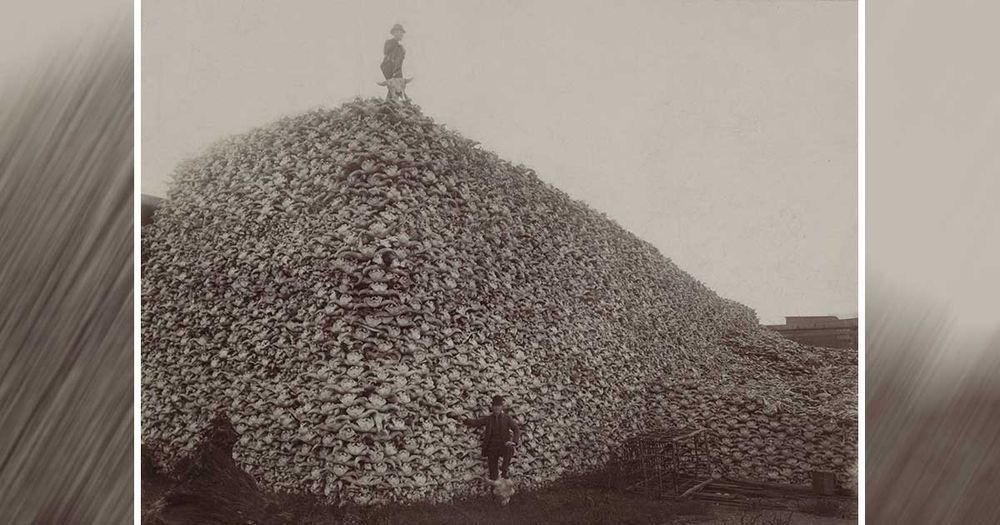How us 'moderns' treated the buffalo: < > h
Post# of 63898

< >

This early American photograph shows two men standing atop a massive mound of bison skulls. The skulls are going to be ground up and turned into fertilizer.
...............................................................................

Who Killed off all the Buffalo?
Posted on March 30, 2012 by David Meyer
Once upon a time, the American buffalo roamed North America in large numbers, perhaps as many as 10-70 million. But by the mid-1880s, its once-vast numbers had been reduced to just a few hundred. Who killed the buffalo? And why?
The Rise of the Buffalo?
Interestingly enough, the rise of the American buffalo may have coincided with the fall of the Native American tribes. According to this theory, put forth by Charles Mann, the Native Americans originally created grasslands for the buffalo population and heavily regulated their activities.
“Hernando De Soto’s expedition staggered through the Southeast for four years in the early 16th century and saw hordes of people but apparently did not see a single bison.” ~ Charles Mann, 1491: New Revelations of the Americas Before Columbus
When the Europeans first arrived in the New World, they inadvertently brought along diseases with them. Native Americans died off in massive numbers and buffalo herds found themselves free. They began to roam and quickly spread across the land, eventually becoming the most dominant large animal in what is now the United States.
Who Killed the Buffalo?
So, that helps explain the spread of the buffalo. But what about the fall? Well, it appears there are a few culprits here…the Native Americans themselves, commercial hunters, and the U.S. Army.
Native Americans, contrary to popular opinion, were not quite the “noble savages” they are often portrayed to be in modern culture. They hunted buffalo in large numbers, even going so far as to herd them into makeshift chutes and stampede them over cliffs (this took place at the well-named Head-Smashed-In Buffalo Jump in Alberta, Canada along with many others). The Comanche alone killed more than 280,000 buffalo a year.
“They were killing more than 280,000 bison a year – the maximum loss the herds could sustain without imploding – and at the very time the great drought of 1845-50 was exacerbating the situation.” ~ Frank McLynn, Review of The Comanche Empire by Pekka Hämäläinen
At the same time, commercial hunters sought the buffalo out with relentless ferocity. These hunters were primarily concerned with gathering skins and would often leave rotting carcasses behind. This was a classic example of the Tragedy of the Commons.
“Because buffalo hides could be sold for as much as $3.50 each, an individual hunter would kill more than a hundred a day for as many days as he cared to hunt on the open plain.” ~ Thomas J. DiLorenzo, The Culture of Violence in the American West: Myth versus Reality
And finally, we come to the last prominent killer of the buffalo…the U.S. Army. In 1865, General William Sherman, fresh out of the American Civil War, was put in charge of the Military Division of the Mississippi (later called the Military Division of the Missouri). He proceeded to launch a two and a half decade war against the Plains Indians, as a sort of under the table subsidy to the government-subsidized transcontinental railroad companies. Other generals, most prominently General Phillip Sheridan, received other commands with the same purpose.
The U.S. Army waged total war against the Native Americans, in search of what General Sherman referred to as the “final solution of the Indian problem.” Since the Native Americans depended on the buffalo for food, clothing, and other things, the U.S. Army targeted it for extinction.
“Let them kill, skin, and sell until the buffalo is exterminated, as it is the only way to bring lasting peace and allow civilization to advance.” ~ General Sherman, Bury My Heart at Wounded Knee: An Indian History of the American West by Dee Brown
Guerrilla Explorer’s Analysis
By 1884, America’s buffalo population had been decimated. In fact, if it weren’t for the efforts of people like Pete Dupree and James “Scotty” Philip (aka The Man who Saved the Buffalo), it stands to reason they might’ve gone completely extinct.
Since then, the buffalo has undergone somewhat of a resurgence and its numbers have risen well above one hundred thousand. Most of these buffalo are privately owned with the notable exception of the Yellowstone Park bison herd. While its unlikely the buffalo will ever regain its former numbers, we can be thankful that it has recovered from near decimation at the hands of Native Americans, hunters, and the U.S. Army.

 (0)
(0) (0)
(0)